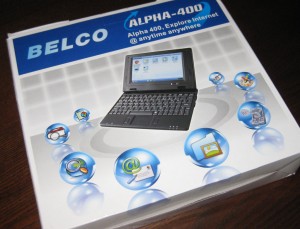Thanks to Måns for contributing FATE build/test results for the MIPS64 architecture, courtesy of his Gdium. This is in addition to his existing contributions for ARM, Alpha, and AVR32 architectures.
Tag Archives: mips
More Non-x86 Subnotebook News
Maybe it’s almost time for cheap, non-x86, subnotebooks to hit the mainstream. I just read about the ARM-based Pegatron at Endgadget. I wager this won’t be as difficult to compile software for as the MIPS subnotebook is turning out to be.
Meanwhile, those Gdium people recently announced a program that they affectionately refer to as One Laptop Per Hacker (OLPH). The idea is to allow interested hackers to obtain pre-release access to Gdium units. I signed up for the program but never bothered to announce it here; hey, anything to reduce potential competition.
Anyway, I got an email tonight notifying me that I am accepted into the program. I’m getting cold feet, though, especially over the legal agreement I am expected to sign in order to procure the pre-release unit. If I wasn’t already in possession of my other MIPS subnotebook, I would jump right on top of this.
OTOH, this unit will undoubtedly be easier to develop for, since it’s partially designed for that purpose. Plus, it’s 64-bit (though I don’t know if that really means anything in the grand scheme of MIPS chips).
What do you think? Should I go for it, for the sake of FATE and the greater FFmpeg project?
Adventures In MIPS Tools
I’m trying to compile a program that will run on my new MIPS-based subnotebook. I finally got a cross-compiling toolchain built and building a super-simple C program. But the program failed to run. When I tried to run my sample program, the shell complained about not knowing what to do with a ‘(‘ character. Puzzling.
This is the ‘file’ type of my compiled program:
ELF 32-bit MSB executable, MIPS, MIPS-I version 1 (SYSV), statically linked, not stripped
I finally thought to extract a binary from the MIPS machine and check its file type:
ELF 32-bit LSB executable, MIPS, version 1 (SYSV), dynamically linked (uses shared libs), stripped
Okay, I think I’m getting wise to the discrepancy already. It turns out that I want a target called “mipsel” rather than just plain “mips” as the former specifies little endian (and because a MIPS CPU can be wired to run either endian — that’s how simple and reduced this reduced instruction set is).
So I rebuilt the toolchain using the ‘mipsel’ target (building the toolchain is surprisingly quick when you know how). Now the test program segfaults when I try to run it. That’s unfortunate, though I still perceive it to be a step up from the last position. This is the new type reported by ‘file’:
ELF 32-bit LSB executable, MIPS, MIPS-I version 1 (SYSV), statically linked, not stripped
It’s MIPS-I version 1, vs. simply MIPS version 1, which is what the existing binaries are. I wonder if that’s the problem? I’m also struggling with a linker warning about the start location. That’s more likely to be the issue.
BTW, this is the C code I am testing with:
int main()
{
return 77;
}
My thinking here is that I should be able to run the program followed by “echo $?” to get the last command’s exit status– 77 in this case.
Got A Cheap MIPS Subnotebook
I bit the proverbial bullet and ordered that cheap MIPS-based subnotebook from Geeks.com. Ordering was a comedy of errors as something went wrong with the order while I was away on vacation and was cancelled upon my return, which is when I noticed that the subnotebook had decreased in price by another $20, a discount that has since ended. But the Alpha-400 arrived today, almost at the same time that I read the Engadget headline EMTEC’s sub-$400 10-inch Gdium netbook gets specced. The Gdium, you might recall, is another, slightly more capable, MIPS-based laptop slated for general availability somewhere between now and the end of time. The headline made me think that the laptop’s release is eminent. But a deeper investigation reveals no firm or even loose commitment regarding shipment.

But I have the cheaper MIPS-based laptop in my hands, one that goes by many names. In this region, it is called the Belco Alpha-400. Let’s see what it can do. Continue reading